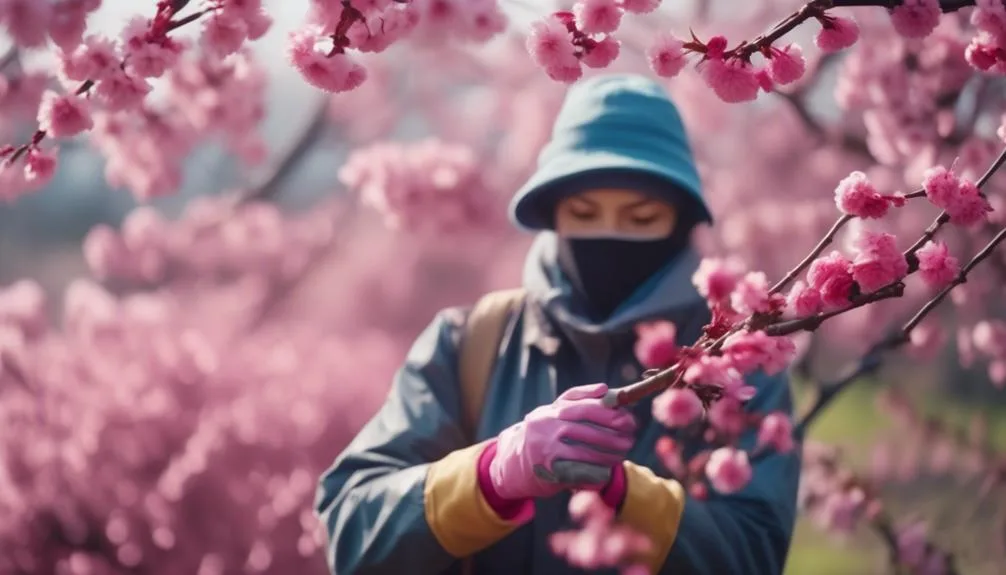Encouraging cherry trees to bloom is all about giving them the right care and attention. Understanding the key factors that influence blooming, like proper pruning and soil pH, can make a big difference.
With the right strategies, you can help your cherry tree burst into a beautiful display of flowers.
Pruning Techniques
Have you ever wondered how to prune your cherry trees to encourage more abundant and beautiful flowering?
One key technique is branch thinning. This involves carefully removing some of the older and less productive branches to allow more sunlight and airflow to reach the remaining ones. By doing this, you can promote better flowering and fruit production.
When pruning, it's essential to follow proper techniques to avoid damaging the tree. Additionally, it's crucial to establish a regular watering schedule for your cherry trees. Consistent and adequate watering, especially during dry periods, can help ensure the tree's health and encourage optimal flowering.
Proper Fertilization
To ensure your cherry trees continue to flourish after branch thinning, it's crucial to understand the proper fertilization techniques that will support their growth and encourage abundant flowering.
When fertilizing your cherry trees, it's important to choose a balanced fertilizer with a formulation such as 10-10-10, which indicates the ratio of nitrogen, phosphorus, and potassium. This balanced blend provides the essential nutrients needed for healthy growth and flower production.
Proper fertilization promotes nutrient absorption, enabling the cherry trees to take up essential elements from the soil, supporting their overall health. Additionally, the right combination of nutrients contributes to growth promotion, encouraging the development of robust branches and an abundance of beautiful blossoms.
Applying fertilizer in early spring and late fall will provide the necessary nutrients for your cherry trees to thrive and produce an impressive display of flowers.
Adequate Sunlight
For cherry trees to thrive and flower abundantly, ensuring they receive adequate sunlight is essential for their growth and blossoming. Adequate sunlight is crucial for blossom timing and growth patterns.
Here's how you can ensure your cherry trees receive the right amount of sunlight:
- Direct Sunlight: Position your cherry trees in a location where they can receive direct sunlight for at least 6-8 hours a day.
- Avoid Shade: Keep the surrounding area clear of any obstructions that may cast shade on the trees, such as tall buildings or large trees.
- Morning Sun: Ideally, cherry trees should receive the morning sun, which helps dry the dew on the leaves, reducing the risk of diseases.
- Monitor Sunlight Changes: Be mindful of any changes in the surrounding landscape that may affect the amount of sunlight your cherry trees receive.
With these tips, you can ensure your cherry trees get the sunlight they need to flourish and blossom beautifully.
Soil Ph Adjustment
Curious about how to adjust the pH of your soil to promote optimal cherry tree growth and flowering? Well, the first step is to conduct a soil test to determine the current pH level.
Cherry trees thrive in slightly acidic soil with a pH range of 6.0 to 6.8. If your soil is too acidic, below the ideal range, consider applying lime to raise the pH level. The amount of lime needed depends on the soil's texture and the degree of pH adjustment required.
It's essential to follow the recommended application rates to avoid over-liming, which can harm the cherry trees. By carefully adjusting the soil pH through lime application, you can create the perfect growing environment for your cherry trees, encouraging healthy growth and abundant flowering.
Frost Protection
When protecting your cherry trees from frost, it's essential to implement effective strategies to safeguard their delicate blossoms and buds.
To protect your cherry trees from frost, consider the following methods:
- Mulching methods: Apply a layer of mulch around the base of the tree to insulate the roots and regulate soil temperature.
- Heat lamps: Use heat lamps or frost cloth to provide supplemental warmth during cold nights, protecting the blossoms and buds from freezing temperatures.
- Selecting the right location: Plant your cherry trees in a location that minimizes exposure to frost pockets or cold air drainage.
- Watering strategies: Keep the soil adequately moist before an expected frost, as moist soil retains more heat than dry soil and can help moderate temperature fluctuations.
Conclusion
In nurturing your cherry trees with proper pruning, fertilization, sunlight, pH adjustment, and frost protection, you're cultivating the potential for a stunning display of cherry blossoms.
With care and attention, your garden will soon be graced with the beauty of nature's delicate blooms.
Happy gardening!
Mark Hoffman is a dedicated arborist and tree care specialist with over a decade of experience. His love for trees began when he visited Yosemite National Park as a teenager and was awestruck by the giant sequoias. Mark pursued his passion by studying forestry at Michigan Technological University, where he earned a Bachelor of Science degree.
Since then, he has worked tirelessly in the field of arboriculture, helping to preserve and protect trees in his community. His expertise and dedication have made him a respected leader in the industry and a valuable resource for anyone seeking advice on tree care.
